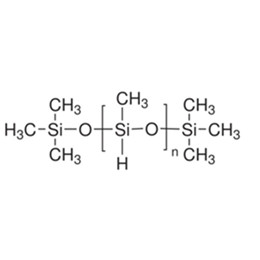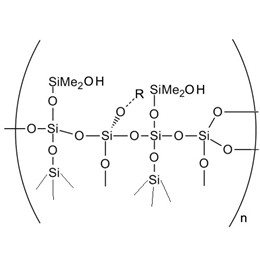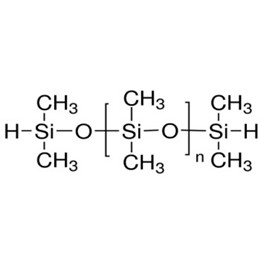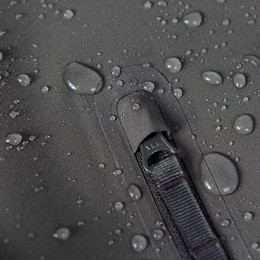Silicones, i.e. organosilicon compounds, are compounds that contain Si-C bonds and have at least one organic group directly connected to the silicon atom. It is customary to also treat compounds that have organic groups connected to the silicon atom through oxygen, sulphur, nitrogen, etc. as silicone compounds.
![]()
![]()
The cross-linked macromolecular structure of silicone resins and the structure of silica crystals (e.g. quartz, etc.) have very similar silicon-oxygen bonds, and this structural feature makes silicones have a great affinity for inorganic mineral materials that contain silicon-oxygen bonds. If silicone is applied to the surface of inorganic materials such as brick and stone, the coating film will form an ordered and oriented arrangement, with the Si-O-Si of the silicone molecules adsorbed on the mineral surface and the methyl or other alkyl groups lined up neatly on the outside (see diagram below). Methyl or other alkyl groups have a very low surface tension and are hydrophobic groups, so this oriented arrangement of silicone molecules exhibits a very high degree of hydrophobicity. When water vapour in the air or raindrops come into contact with the surface of the material, the hydrophobic surface of the material acts as a hydrophobic barrier, making it difficult for liquid water to remain on the slope and façade and roll off in the form of water droplets, thus preventing external moisture from penetrating into the cementitious material. In addition to its remarkable water repellency, the silicone coating film is also 'breathable' (see diagram below), maintaining the moisture balance of the cladding itself and thus further advancing the durability of the coating film.
![]()
![]()
The water-repellent effect of this silicone water repellent is fundamentally different from the lotus leaf effect.
The microstructure on the leaf surface of the lotus leaf is shown in the figure below.
![]()
![]()
There are very complex multiple nano- and micron-scale ultrastructures on the leaf surface of the lotus leaf. Under the ultra-high resolution microscope, many tiny papillae can be clearly seen on the surface of the lotus leaf, with the average size of the papillae being about 10 microns and the average spacing being about 12 microns. And each papilla consists of many waxy protrusions with a diameter of about 200 nm. The leaf surface of the lotus leaf is covered with one by one raised "bun", which is full of hairs, and at the top of the "bun" grows a bun-like "bunker" with a convex top, and at the depression between the "buns" is filled with air, so that a layer of air only nanometer thick is formed in the immediate area of the leaf surface. When the size of dust, rain, etc. is much larger than this structure on the leaf surface after landing, separated by a very thin layer of air, can only form a point of contact with the convex top of the leaf surface "berg". The raindrops form a sphere under their own surface tension, and the water ball attracts dust in rolling and rolls out of the leaf surface to achieve self-cleaning, which is the "lotus leaf effect".
What are the main uses of silicone water repellents?
Silicone water repellents can be used for painting the surfaces of decorative mortars, natural or artificial marble, natural or artificial granite, decorative concrete, fair-faced concrete, blocks and bricks, silicone-impregnated leather boots, silicone water guard, sleeping bags, building materials, etc. They mainly play the following roles.
1) Anti-fouling and dust removal
There are a large number of microcracks, depressions and capillaries on the masonry surfaces, concrete and mortar surfaces of the building facades, causing water absorption and dust hanging, and when the atmospheric precipitation mixes with the accumulated dust on the above surfaces to form black sewage downstream, black streaks or flakes are formed after drying. Serious damage to the decorative effect of the finish. But when coated with a silicone waterproofing agent, the formation of the water-repellent film will make the sewage bead roll down, not only to prevent the infiltration of sewage, and sewage water bead rolled down will make the attached dust fall together. Therefore, after heavy or light rain (or artificial water spray) washing of the silicone wall surface is completely different from the untreated wall surface, showing a new look, after the rain pollution serious situation obviously improved.
2) Prevention of weathering and whitening
Weathering is an inorganic salt solution migrated to the surface of the wall to form crystals and volume expansion of the wall cracks produces stress damage and caused by this damage repeatedly year after year, so that the surface of the wall puffy, peeling until the loss of function. Waterproofing agent in the wall surface to form a water-repellent layer, to avoid external precipitation to the internal infiltration and internal salt solution to the external migration, thus eliminating the weathering caused by salt precipitation.
![]()
The white precipitation refers to the outward migration of free calcium hydroxide solution inside the building wall, which is deposited on the surface of the wall after drying and gradually reacts with carbon dioxide to produce water-insoluble carbonate, which permanently adheres to the wall surface and appears as uneven patches of white marks. The uneven migration of the calcium hydroxide solution will cause the wall surface to be white, white, which not only affects the decorative effect, but also has a great destructive effect. The water-repellent layer formed by the silicone coating film on the wall surface is an effective measure to avoid whitening.
3) Prevention of microbial growth
The primary condition for microorganisms to breed on the surface of a building is moisture, and long-term wet surfaces are prone to the growth of moss and various moulds, which breed and multiply causing damage to the surface of the building. After the application of silicone waterproofing agent formed a water-repellent surface layer is difficult to store water, so destructive organisms can not survive.
4) Frost damage prevention
When the water stored in the surface pores or cracks of northern walls freezes, the volume expands by about 10%, and this expansion generates huge damaging stresses, and the water barrier eliminates this damage caused by frost.
![]()
5) Acid rain corrosion prevention
The silicone water-repellent film blocks corrosion damage to the wall from atmospheric acid rain. As mentioned earlier, the silicone coating film has "breathability", so that gas water molecules can enter and exit freely through the coating film, thus maintaining the wall's own moisture balance. The water molecules inside the wall can easily escape to the outside, so that the wall under the coating film maintains a natural wet and dry balance, without causing blisters or surface peeling due to the inability to disperse moisture like a fully enclosed coating film.
![]()
6) Colour retention and anti-ageing effect
For walls with colour, silicone films can be used to retain colour. Because of the high bond energy of the Si-O bond, it is difficult for light energy to destroy it. Once the light energy is absorbed by the Si-O bond in the coating film, it will no longer cause damage to the coloured groups under the silicone coating film, and the colour will remain in its initial state for a long time.
![]()
What are the spray (coating) construction methods of silicone waterproof agents?
The construction of silicone waterproofing agents is generally divided into grass-roots surface cleaning, repair cracks, and spraying construction 3 procedures.
1) Clean up the grass-roots surface
Spray silicone waterproofing agent before the grass-roots surface to clean up the dust, moss spots and other dirt. General dust, floating soil can be flushed with water or rag scrubbing; oil, rust stains, moss spots need to be cleaned carefully with cleaning agents, and then rinse clean residual cleaning agents with water.
2) Repairing cracks
Substrate leakage is divided into capillary absorption leakage and cracks, holes, water seepage in two categories. Silicone waterproofing agent to deal with capillary water absorption leakage is very effective. But if there are large cracks or holes in the grass-roots level, a single spray silicone waterproofing agent often can not solve the problem, because if it rains with high winds, rainwater may still be driven by the larger wind pressure through cracks, holes seep into the grass-roots level. For this reason, you must choose the right material to embed repair cracks, and holes and then spray silicone waterproofing agent.
![]()
3) spraying silicone waterproofing agent
Base layer after cleaning, repair, dry (less than 10% water content), you can spray silicone waterproofing agent.
a) the silicone waterproofing agent and water by 1: (10-12) ratio (quality ratio) mix evenly, with a clean agricultural spray bottle or brush directly on the drywall spray, brush, longitudinal and horizontal continuously 2 times.
b) Spraying order should be standardized, it is best to first down and then up, or first spray the next section, and then from top to bottom segmentation. For example, spraying wall, you can start from the bottom of the construction surface, along the horizontal direction, from left to right or right to left spraying (should be windward), the formation of horizontal construction coating, so gradually sprayed to the top, complete the first spraying; followed by the second spraying in the vertical direction, so that the second coating is "cross", so that the wall fully absorb the emulsion, to prevent leakage of spray. Two points need to be noted when spraying: First, the first and second spraying interval is not too long, such as the first coating after fully cured and then spray the second, the cured coating film has begun to hate water (especially in the high temperature of the summer is even more so), the second will not be sprayed on, sprayed on will also roll off; Second, spraying shall not jump, disorderly or randomly spray to apply maximum repellency, otherwise it is easy to appear less spraying or leakage of spraying phenomenon, affecting the construction quality.
c) wall waistline, balcony, windowsill and other prominent parts and tile, marble and other finishes of the brick joints are spraying key parts, to fully spray.
d) The construction requires the temperature to be above 4℃, no rain, snow, freezing within 24h, wind below level 6, and the diluted liquid with water should be used up on the same day.
e) to strictly control the ratio of emulsion and water, too thick or too thin can not get the desired waterproof effect. General concrete, cement mortar, tile, rough granite, brushed stone, clear water brick wall to 1: (10-11) more appropriate; polished granite, marble wall to 1:12 most appropriate.
![]()




